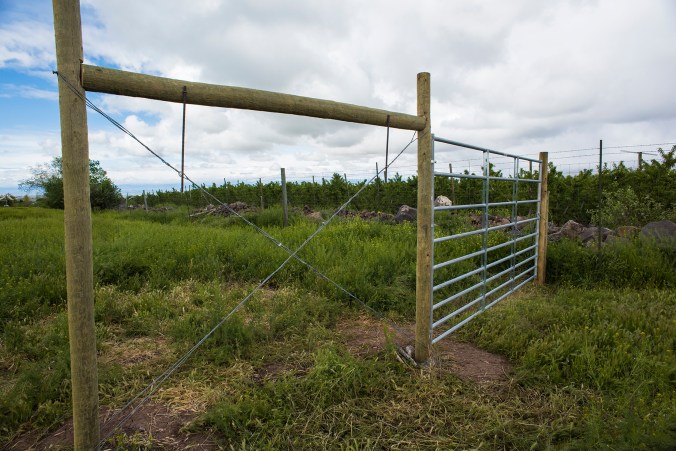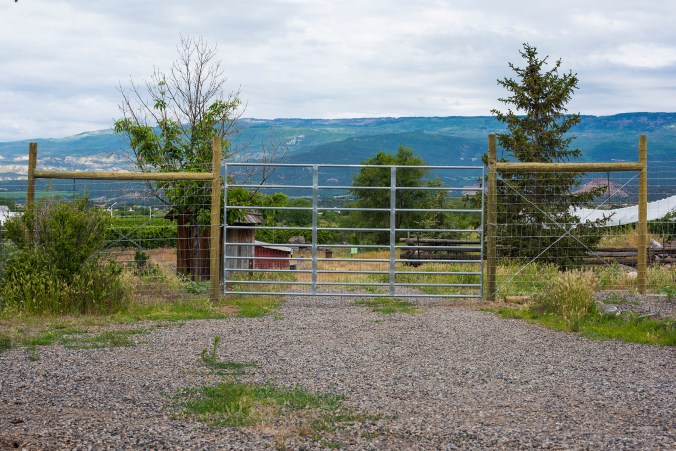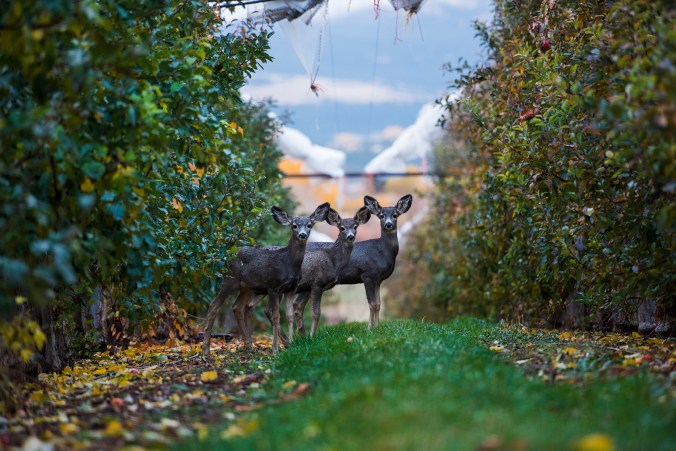
Tools at the ready for constructing an H-brace.
Early this year, Colorado Parks and Wildlife delivered our game fencing materials. They also included a thin pamphlet with a few helpful suggestions on how to construct said fence – not really what we’d call “instructions.” As we’d never built even a simple fence before, this meant a lot of time on the University of YouTube. Our game fence is nine feet tall and composed of wood posts, metal T-posts, two strands of grid wire fencing and three strands of barbed wire. That’s a lot just to keep deer out – and each component has to be installed separately.

Once we’d set our wood posts in concrete, we went around building H-braces at corners. H-braces (seen above on the left and right sides of the gate) are required when the fence turns a corner to keep it supported. The H-braces seem relatively simple – you just notch the vertical posts, insert a horizontal post, then use massive nails (3/8 inch by 12 inches!) to secure the horizontal to the vertical. As with all aspects of this fence, though, this is simpler on paper than in reality. Notching the fenceposts required climbing on a rickety stepladder on very rocky and uneven ground and holding a reciprocating saw at an awkward angle while trying not to fall off the ladder. Not at all OSHA-approved.

Four completed H-braces on either side of our corral gate.
With the posts successfully notched, we set about connecting the horizontal to the vertical. Driving the heavy, thick nails in proved to be yet another challenge. After hours of frustration, we finally bought an extra-long drill bit so we could pre-drill the holes for the nails. This was an important lesson learned: don’t try to do something the hard way if a power tool can make the task easier.

Looking southwest at our pasture gate.
H-braces then have to be wrapped with nine-gauge wire in order to stabilize the posts. As with the nails, this was much easier in theory than in practice. The wire was delivered to us in huge coils which were absolutely unmanageable – no matter where you wanted the wire to go, it was set on uncoiling the wrong way somewhere else, usually slapping you in the face along the way. We each bear our fair share of fence scars.

Using a come-along and a wood clamp to stretch the grid fencing.
Now that the H-braces are up and wrapped, the two strands of grid fencing have to be installed. We could have opted for one-strand fencing, but the fencing comes in 330-feet rolls and the two of us could barely lift one of the smaller rolls. So we chose to wrap two strands, which most small farms do. It takes longer, but it’s much easier for two people to handle.
We unrolled the coils along the fence line, then used a come-along and N’s very crafty wood plank clamp to stretch the fencing. It’s imperative that the fencing be as tight as possible, but because our posts aren’t exactly straight, we had to adapt a bit. We’ll call it “accounting for the curvature of the earth.” Once in place, the fencing was secured to the wood posts using thick staples, and to the T-posts using clips.

Using the wood clamp and the ATV hook and cable to install the top row.
Installing the top row offered additional challenges, since we had to hold up hundreds of feet of fencing while stretching and then securing it. Our ATV’s hook and cable set-up helped a great deal here, as did some sturdy chains attached to our wood plank clamp.

We were pleased (and surprised!) to find that all of our fencing materials were made in the USA.

Waiting for barbed wire along the top and bottom.

Nearly finished!
The complexity of the fence might seem like a bit much just for some deer…but we have watched these animals easily leap a six-foot fence from a standstill. The power in their strong legs and their lean bodies is remarkable, and the fence has to be nine feet tall to have any hope of keeping them out, especially when they’re moving at a full, panicked run.

Dear deer: the Quiet Farm salad bar is officially closed. Go torment someone else.
Building our game fence is the most extensive, complex and difficult project we’ve tackled yet here on Quiet Farm, and we are so proud of the results. The fence isn’t perfect, but we did it ourselves for about one-tenth what it would have cost to hire a fencing company, and we learned so much along the way. This sense of accomplishment and self-sufficiency is why we’re out here.
Thanks for reading!














